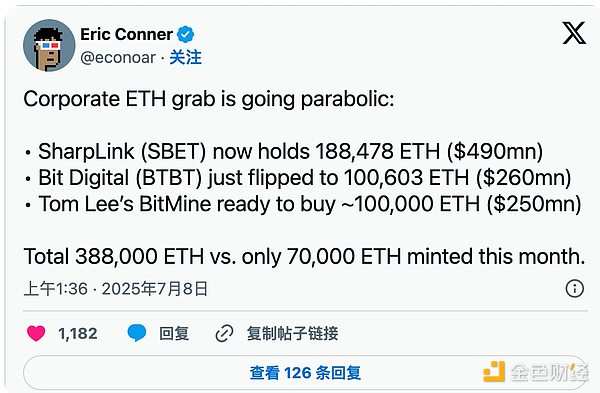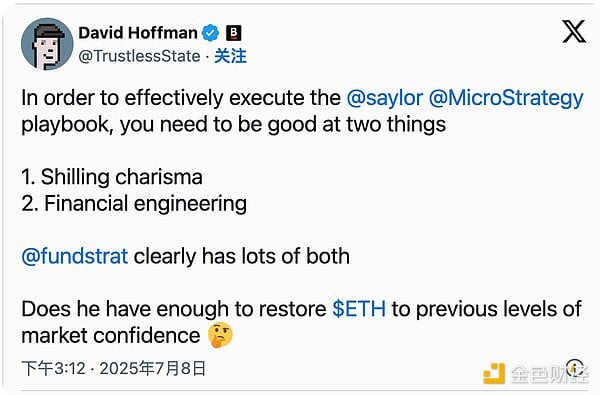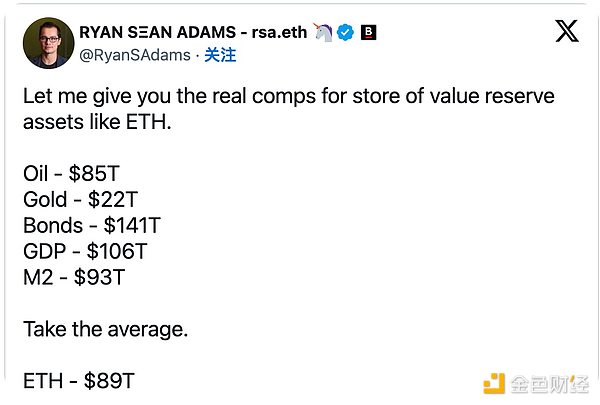You may have noticed that my stance on Ethereum (ETH) has softened recently. The decline in ETH's relative valuation has led to a loss of investor confidence, and confidence is crucial when ETH aspires to become an internet currency.
For years, the reasons for Ethereum's underperformance have been a point of contention. Many issues troubling ETH's relative valuation are beyond its control - contributions from Gary Gensler, Michael Saylor, and others. (Gensler has left, and the ETH Treasury company has finally emerged; some external issues will resolve themselves.)
But today, I want to focus on challenges the Ethereum community can control, because Ethereum has lagged in the market for over three years, many of which are within its own control. We should concentrate on solving these issues to reignite potential ETH buyers' interest.
ETH's Value Capture Problem
Many challenges Ethereum faces can be distilled to one core theme: a broken value capture supply chain between Ethereum's utility and ETH's value.
"I'm surprised... the stablecoin usage on Ethereum, Solana, TRON... hasn't brought more value to the token holders of these underlying chains." - Joe Weisenthal
Regarding stablecoins, concerns about the relationship between a chain's stablecoin supply and its L1 token's value capture have existed since the 2018-2019 bear market.
In short, stablecoin buyers and holders on Ethereum's Layer 1 bring no value to ETH beyond paying around $0.50 in fees to purchase these stablecoins. If they do this on Layer 2, even with billions of dollars in stablecoin purchases, ETH's value capture would drop below $0.01.
Ethereum's Development Momentum
Nevertheless, Ethereum's adoption indicators are undoubtedly optimistic.
Robinhood's recent announcement of launching Robinhood Chain and deploying tokenized stocks on Ethereum validates Ethereum's Layer 2 roadmap and its position as a trustless settlement layer for Wall Street assets. Robinhood Chain's emergence marks the upgrade of blockchain technology to Wall Street's antiquated financial system, with the promise of tokenization and trading becoming a reality.
This event is just one of many bullish signals for Ethereum:
1. Ethereum ecosystem occupies 50% of stablecoin supply, which approaches 75% if not considering the opaque TRON ecosystem;
2. Circle's significant IPO specifically validates Ethereum, as Ethereum holds 66% of all USDC;
3. Coinbase is building an Ethereum L2;
4. Ethereum's 100% uptime and prioritization of true decentralization (no counterparty) align with Wall Street's needs and enhance its brand image relative to alternatives;
5. The economic influence of the ETH Financial Company is continuously strengthening.

If you want to build an optimistic narrative for ETH and Ethereum, it's becoming increasingly easier to do so.
The diligent efforts of Ethereum developers to maintain decentralization and trustless neutrality have now yielded remarkable results, with significantly increased adoption in the world's financial center, Wall Street.
Ethereum Narrative Expansion Kit
Many see opportunities in these adoptions and successes.
Tom Lee's Bitmine fund management strategy is leveraging Ethereum's narrative influence. The strategy is simple: incorporate ETH into the balance sheet, then sell ETH to Wall Street. Ethereum itself has many narrative highlights; all ETH needs is someone compelling enough to excite Wall Street.

We are about to witness how undervalued ETH has been over the past four years. Is ETH's poor price performance due to market irrationality? Or does its decline truly reflect deeper, more structural issues?
Tribalism and Social Scalability
Delving deeper into the above, you'll gain a more profound understanding of two aspects of ETH.
On one hand, a network adopting the L2 model breaks a link in ETH's value capture supply chain. On the other hand, you'll see an incredibly successful story that seems just a gentle push from Wall Street away from ETH reaching $10,000.
Here's my perspective on this dichotomy:
If narrative power is added before resolving the value capture supply chain, it creates a form of tribalism beloved by insiders but rejected by outsiders.

Now, most people within Ethereum would be excited to see Ryan's proposed ETH price of $740,000, while those outside Ethereum might view this as delusional (just look at the comments on X).
However, let's imagine an alternative scenario where Ethereum's excellent value capture supply chain becomes the core narrative of Ethereum, just like in 2021. In this case, all Ethereum L2s become native + Rollup-based, and Ethereum's block time is reduced to around 2 seconds (which is Ethereum's long-term goal).
In this world:
Rollups have synchronous composability, thus eliminating the need for network bridges. Lower Layer1 block times allow market makers to provide tighter spreads, thereby bringing greater on-chain trading volume and significantly improved price execution.
Ethereum's powerful MEV infrastructure can ultimately be used to provide optimal execution for traders (on assets like meme coins), instead of charging around 20% fees as elsewhere
Cross-chain liquidity flows back to Layer1, and native + Rollup-based solutions can seamlessly integrate with Layer1 liquidity, increasing trading volume.
Rollups consume 10 to 100 times more gas than current L2s, while providing shared liquidity and composability, which means that all these activities on Rollups will actually consume a considerable amount of ETH
Tokenized assets on Rollups are accessible throughout the Ethereum ecosystem. Ethereum's position as a platform for tokenized asset issuance and trading will be further enhanced.
The above describes a future of Ethereum where the feedback loop between Ethereum's utility and ETH value capture is restored.
Breaking Tribal Narrative
In 2024, Bitcoin leaped from an asset primarily promoted by its community group to an asset viewed as a "special snowflake" by the world's most powerful governments. Only Bitcoin has strategic reserves, a characteristic not shared by other assets.
Bitcoin's fundamentals (a cap of 21 million) motivate non-speculative investors to hold at least a small amount of Bitcoin.
Ethereum needs to do the same.
While Tom Lee and all other ETH financial strategy firms are spreading the gospel of ETH to Wall Street, it would be even better if they could stand on a coherent value capture story and use it as leverage.
The Ethereum community must quickly repair the feedback loop between Ethereum's utility and ETH value. We are clear about the required inputs. We are also clear about the stakeholders, including many who are already working towards this vision, and a few who might need to be convinced by other community members. We believe we can achieve this goal.
What are the stakes? A more effective Ethereum growth story that we can promote to the world - a story that ultimately allows Ethereum to realize the vision its supporters expect: breaking through the $10,000 mark, and perhaps even higher.







